Verra Mobility (VRRM)
Verra Mobility is interesting. Its marriage of growth and profitability makes it a strong business with attractive upside.― StockStory Analyst Team
1. News
2. Summary
Why Verra Mobility Is Interesting
Aiming to wrap technology and data around a historically manual and paper-based industry, Verra Mobility (NYSE:VRRM) is a leading provider of smart mobility technology to address tolls and violations, title and registration services, as well as safety and traffic enforcement.
- Impressive 18.4% annual revenue growth over the last five years indicates it’s winning market share this cycle
- Offerings are difficult to replicate at scale and result in a best-in-class gross margin of 61.8%
- One pitfall is its low returns on capital reflect management’s struggle to allocate funds effectively


Verra Mobility is close to becoming a high-quality business. If you like the stock, the valuation looks reasonable.
Why Is Now The Time To Buy Verra Mobility?
High Quality
Investable
Underperform
Why Is Now The Time To Buy Verra Mobility?
Verra Mobility is trading at $21.40 per share, or 16.1x forward P/E. Verra Mobility’s multiple is lower than that of many industrials companies. Even so, we think it is justified for the top-line growth you get.
It could be a good time to invest if you see something the market doesn’t.
3. Verra Mobility (VRRM) Research Report: Q3 CY2025 Update
Traffic solutions company Verra Mobility (NYSE:VRRM) reported Q3 CY2025 results exceeding the market’s revenue expectations, with sales up 16.1% year on year to $261.9 million. The company’s full-year revenue guidance of $960 million at the midpoint came in 3.1% above analysts’ estimates. Its non-GAAP profit of $0.37 per share was 7.7% above analysts’ consensus estimates.
Verra Mobility (VRRM) Q3 CY2025 Highlights:
- Revenue: $261.9 million vs analyst estimates of $238.5 million (16.1% year-on-year growth, 9.8% beat)
- Adjusted EPS: $0.37 vs analyst estimates of $0.34 (7.7% beat)
- Adjusted EBITDA: $113.3 million vs analyst estimates of $107.4 million (43.3% margin, 5.5% beat)
- The company lifted its revenue guidance for the full year to $960 million at the midpoint from $930 million, a 3.2% increase
- Management reiterated its full-year Adjusted EPS guidance of $1.33 at the midpoint
- EBITDA guidance for the full year is $415 million at the midpoint, in line with analyst expectations
- Operating Margin: 28.6%, in line with the same quarter last year
- Free Cash Flow Margin: 18.7%, down from 37.7% in the same quarter last year
- Market Capitalization: $3.83 billion
Company Overview
Aiming to wrap technology and data around a historically manual and paper-based industry, Verra Mobility (NYSE:VRRM) is a leading provider of smart mobility technology to address tolls and violations, title and registration services, as well as safety and traffic enforcement.
Verra Mobility was originally established as a traffic enforcement technology business. Today, it offers products addressing smart mobility technology including a wider range of services such as automated government systems and parking solutions.
Specifically, the company provides automated toll and violations management services to rental car companies, direct commercial fleets, and fleet management companies in North America and Europe. It also manages regional toll transponder installations and ensures transponders are correctly linked to specific vehicles. In the realm of government services, Verra Mobility supplies automated safety solutions, including road safety cameras. These systems are capable of detecting various traffic violations such as red-light infractions and speeding. Verra Mobility’s end-to-end solutions support government agencies by installing and maintaining equipment, processing violation data, and managing citation issuance and other administrative functions.
Following the acquisition of T2 Systems in December 2021, Verra Mobility expanded into parking management. T2 Systems is recognized for delivering end-to-end parking solutions, particularly to universities, municipalities, and healthcare facilities. Its parking technologies include software and hardware for managing parking access and revenue, such as multi-space pay stations and mobile payment platforms. One specific product, UNIFI Mobile integrates various parking-related transactions into a unified mobile-first platform, enhancing operational efficiency for parking operators and convenience for end-users.
The company's revenue is generated by fees and contracts from the services mentioned above.
4. Electrical Systems
Like many equipment and component manufacturers, electrical systems companies are buoyed by secular trends such as connectivity and industrial automation. More specific pockets of strong demand include Internet of Things (IoT) connectivity and the 5G telecom upgrade cycle, which can benefit companies whose cables and conduits fit those needs. But like the broader industrials sector, these companies are also at the whim of economic cycles. Interest rates, for example, can greatly impact projects that drive demand for these products.
Competitors of Verra Mobility include Conduent Transportation (NASDAQ:CNDT), Cubic (private, acquired by Veritas Capital), and European competitor Kapsch TrafficCom AG (OTCMKTS:KPSHF).
5. Revenue Growth
Reviewing a company’s long-term sales performance reveals insights into its quality. Any business can put up a good quarter or two, but the best consistently grow over the long haul. Luckily, Verra Mobility’s sales grew at an incredible 18.4% compounded annual growth rate over the last five years. Its growth surpassed the average industrials company and shows its offerings resonate with customers, a great starting point for our analysis.
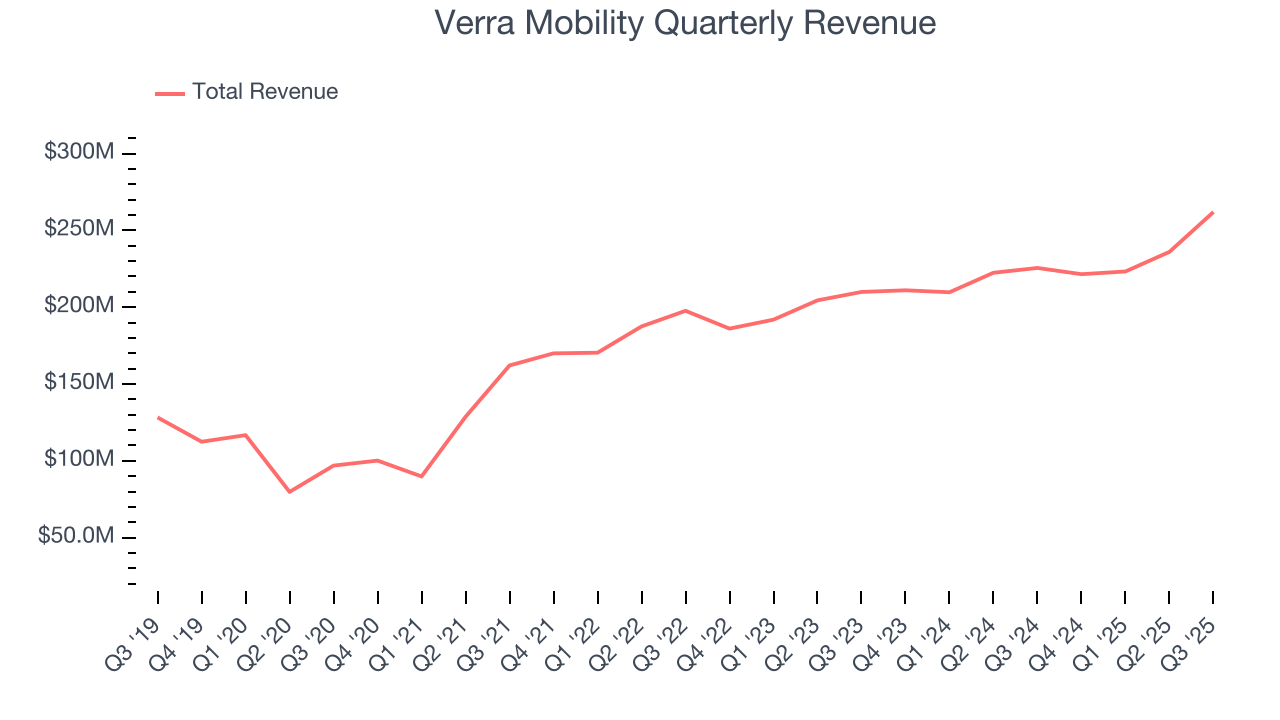
Long-term growth is the most important, but within industrials, a half-decade historical view may miss new industry trends or demand cycles. Verra Mobility’s annualized revenue growth of 9.1% over the last two years is below its five-year trend, but we still think the results suggest healthy demand. Verra Mobility’s recent performance shows it’s one of the better Electrical Systems businesses as many of its peers faced declining sales because of cyclical headwinds. 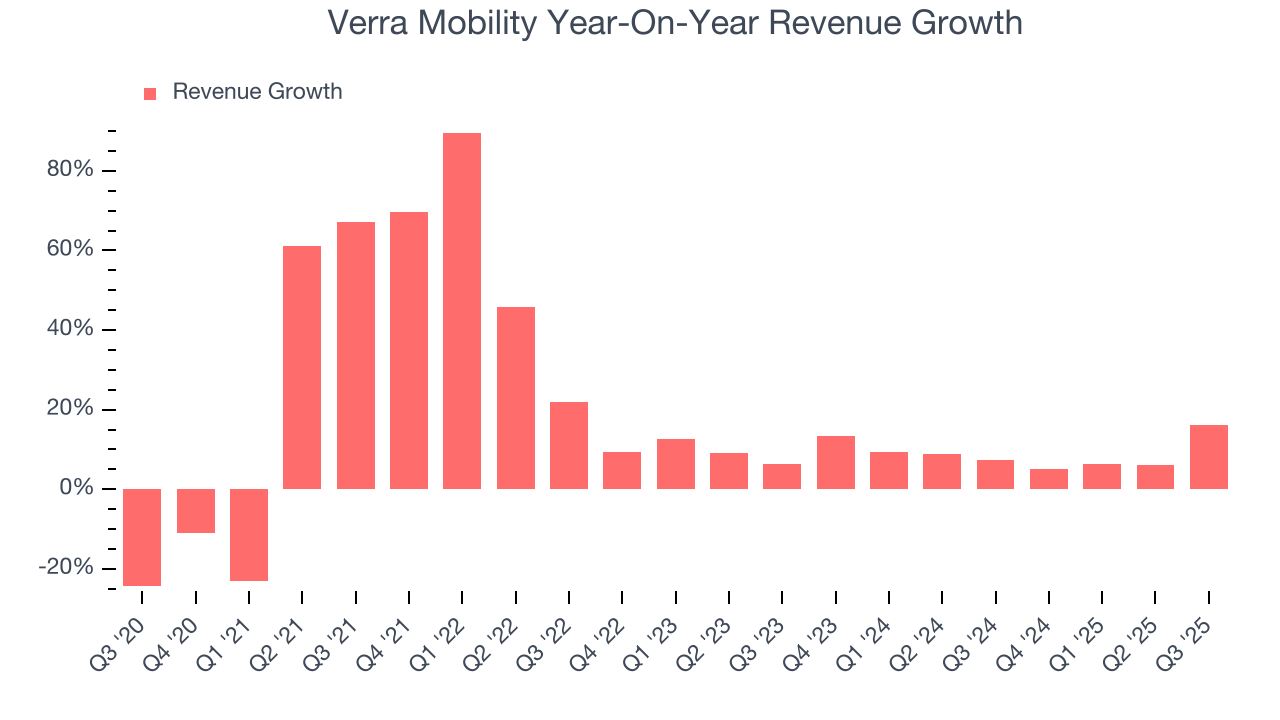
This quarter, Verra Mobility reported year-on-year revenue growth of 16.1%, and its $261.9 million of revenue exceeded Wall Street’s estimates by 9.8%.
Looking ahead, sell-side analysts expect revenue to grow 5.4% over the next 12 months, a deceleration versus the last two years. This projection doesn't excite us and indicates its products and services will see some demand headwinds. At least the company is tracking well in other measures of financial health.
6. Gross Margin & Pricing Power
All else equal, we prefer higher gross margins because they make it easier to generate more operating profits and indicate that a company commands pricing power by offering more differentiated products.
Verra Mobility has best-in-class unit economics for an industrials company, enabling it to invest in areas such as research and development. Its margin also signals it sells differentiated products, not commodities. As you can see below, it averaged an elite 61.8% gross margin over the last five years. That means Verra Mobility only paid its suppliers $38.17 for every $100 in revenue. 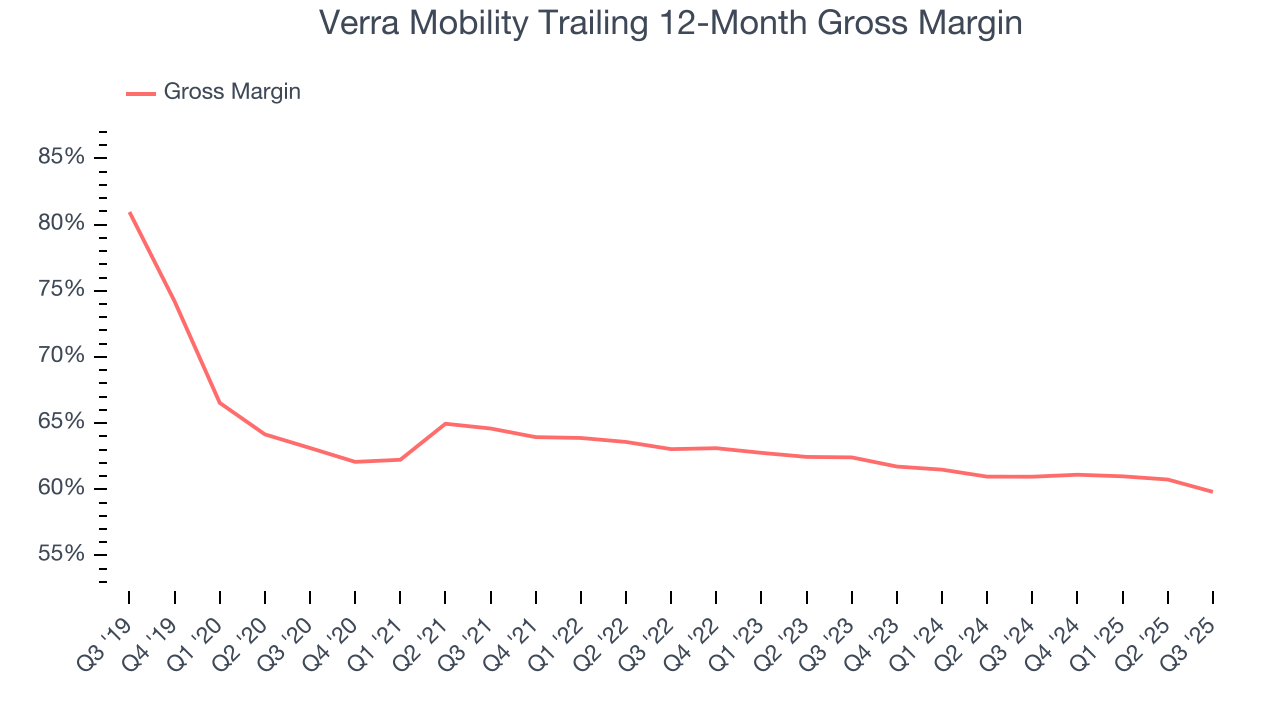
In Q3, Verra Mobility produced a 58% gross profit margin, marking a 3.5 percentage point decrease from 61.4% in the same quarter last year. Verra Mobility’s full-year margin has also been trending down over the past 12 months, decreasing by 1.1 percentage points. If this move continues, it could suggest a more competitive environment with some pressure to lower prices and higher input costs (such as raw materials and manufacturing expenses).
7. Operating Margin
Verra Mobility has been a well-oiled machine over the last five years. It demonstrated elite profitability for an industrials business, boasting an average operating margin of 21.2%. This result isn’t surprising as its high gross margin gives it a favorable starting point.
Looking at the trend in its profitability, Verra Mobility’s operating margin decreased by 1.6 percentage points over the last five years. This raises questions about the company’s expense base because its revenue growth should have given it leverage on its fixed costs, resulting in better economies of scale and profitability.
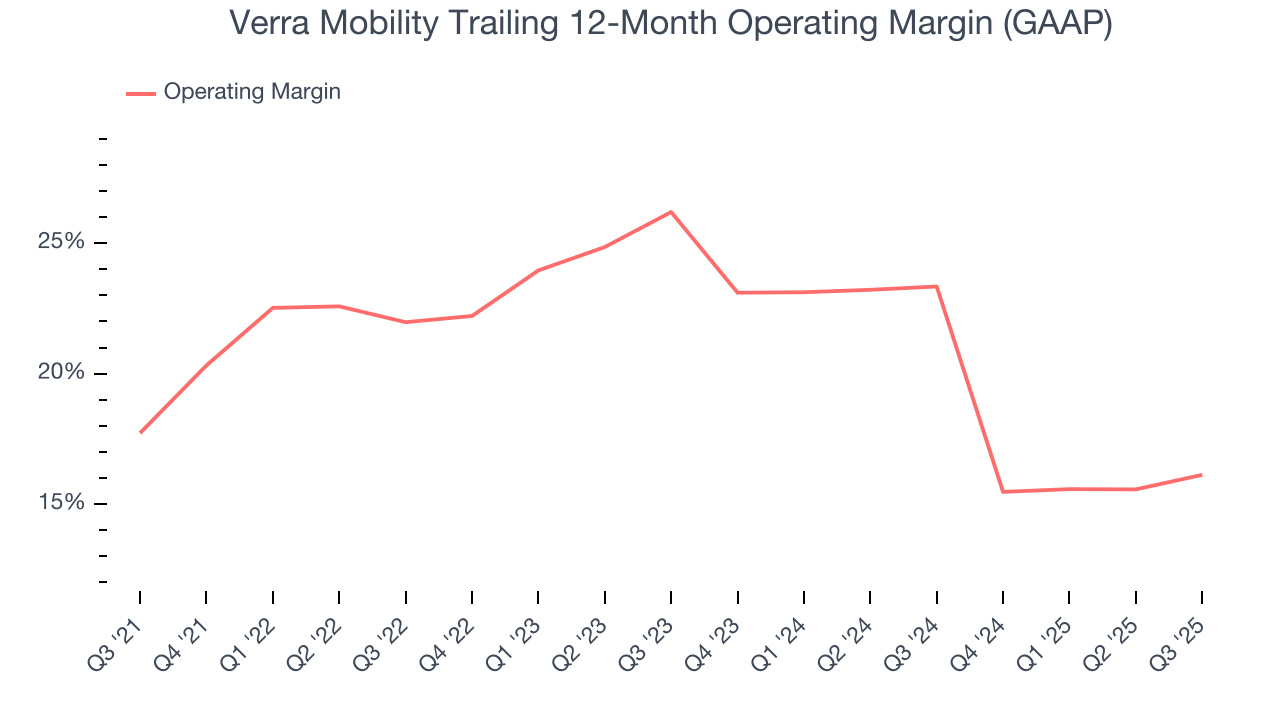
This quarter, Verra Mobility generated an operating margin profit margin of 28.6%, in line with the same quarter last year. This indicates the company’s cost structure has recently been stable.
8. Earnings Per Share
We track the long-term change in earnings per share (EPS) for the same reason as long-term revenue growth. Compared to revenue, however, EPS highlights whether a company’s growth is profitable.
Verra Mobility’s EPS grew at an astounding 20.4% compounded annual growth rate over the last five years, higher than its 18.4% annualized revenue growth. This tells us the company became more profitable on a per-share basis as it expanded.
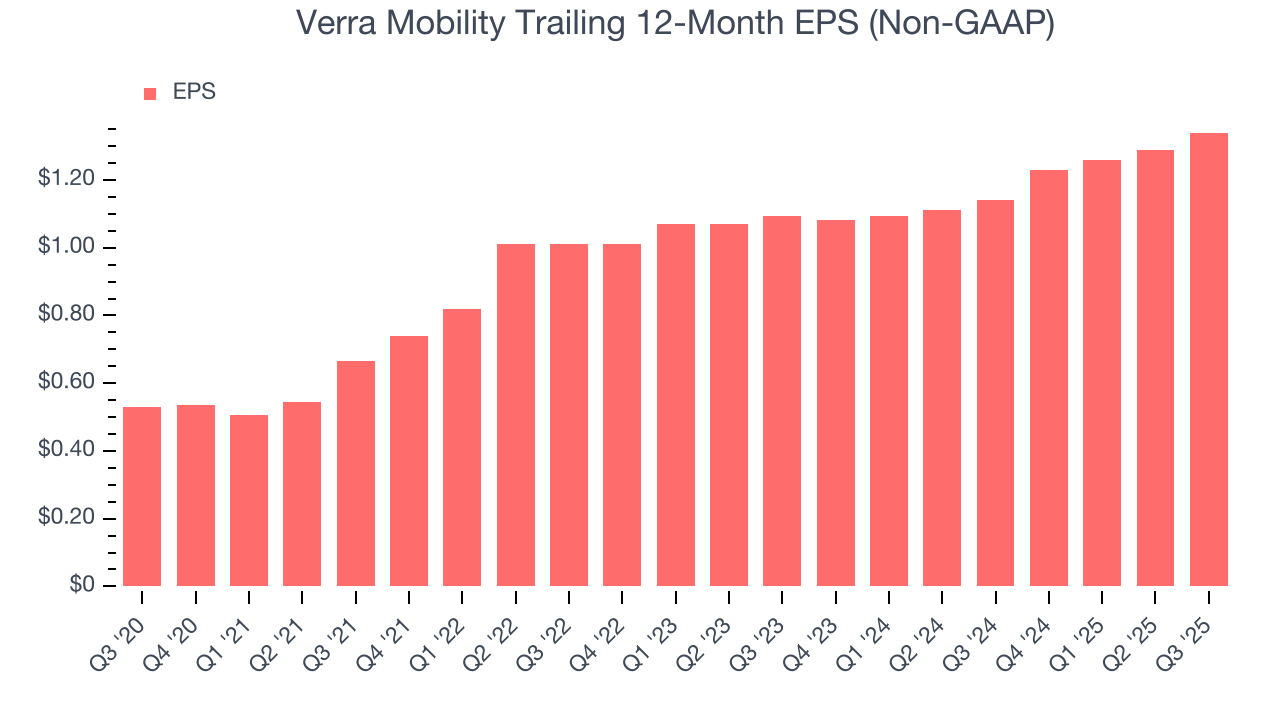
Like with revenue, we analyze EPS over a shorter period to see if we are missing a change in the business.
For Verra Mobility, its two-year annual EPS growth of 10.8% was lower than its five-year trend. We still think its growth was good and hope it can accelerate in the future.
In Q3, Verra Mobility reported adjusted EPS of $0.37, up from $0.32 in the same quarter last year. This print beat analysts’ estimates by 7.7%. Over the next 12 months, Wall Street expects Verra Mobility’s full-year EPS of $1.34 to grow 8.6%.
9. Cash Is King
Free cash flow isn't a prominently featured metric in company financials and earnings releases, but we think it's telling because it accounts for all operating and capital expenses, making it tough to manipulate. Cash is king.
Verra Mobility has shown terrific cash profitability, putting it in an advantageous position to invest in new products, return capital to investors, and consolidate the market during industry downturns. The company’s free cash flow margin was among the best in the industrials sector, averaging 20.2% over the last five years.
Taking a step back, we can see that Verra Mobility’s margin dropped by 6.7 percentage points during that time. If its declines continue, it could signal increasing investment needs and capital intensity.
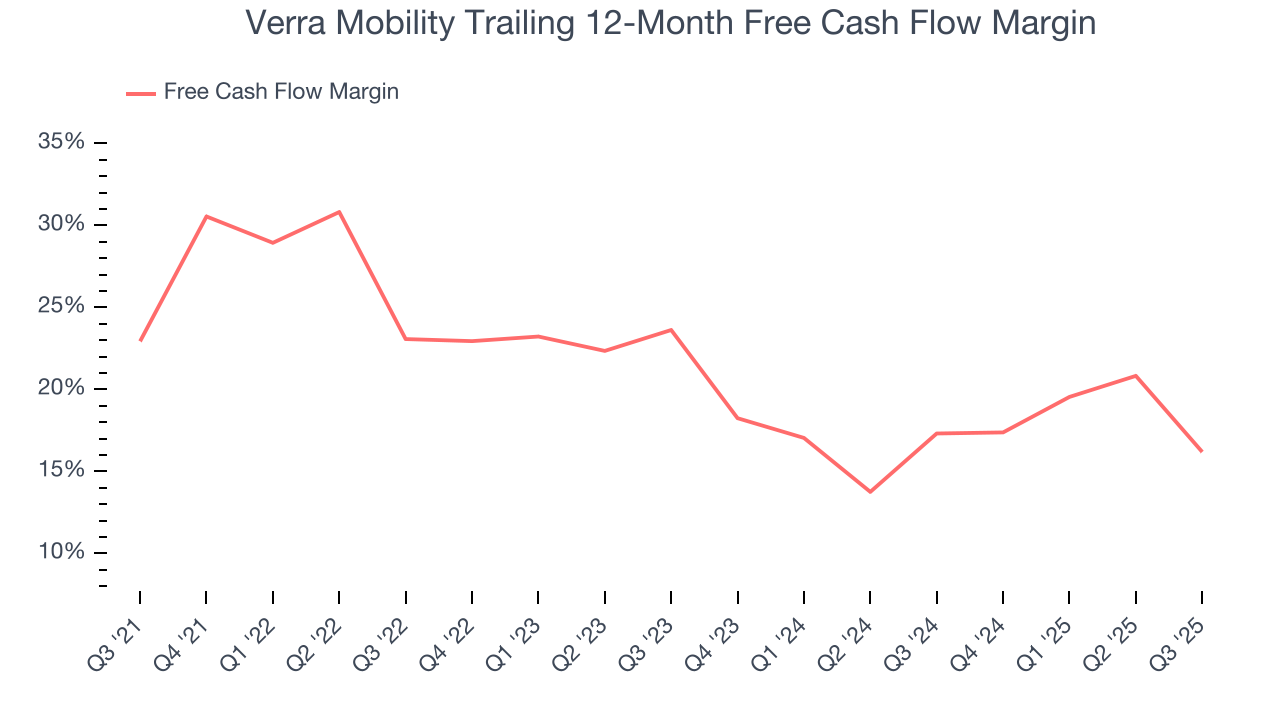
Verra Mobility’s free cash flow clocked in at $48.97 million in Q3, equivalent to a 18.7% margin. The company’s cash profitability regressed as it was 19 percentage points lower than in the same quarter last year, which isn’t ideal considering its longer-term trend.
10. Return on Invested Capital (ROIC)
EPS and free cash flow tell us whether a company was profitable while growing its revenue. But was it capital-efficient? A company’s ROIC explains this by showing how much operating profit it makes compared to the money it has raised (debt and equity).
Although Verra Mobility has shown solid business quality lately, it historically did a mediocre job investing in profitable growth initiatives. Its five-year average ROIC was 9.6%, somewhat low compared to the best industrials companies that consistently pump out 20%+.
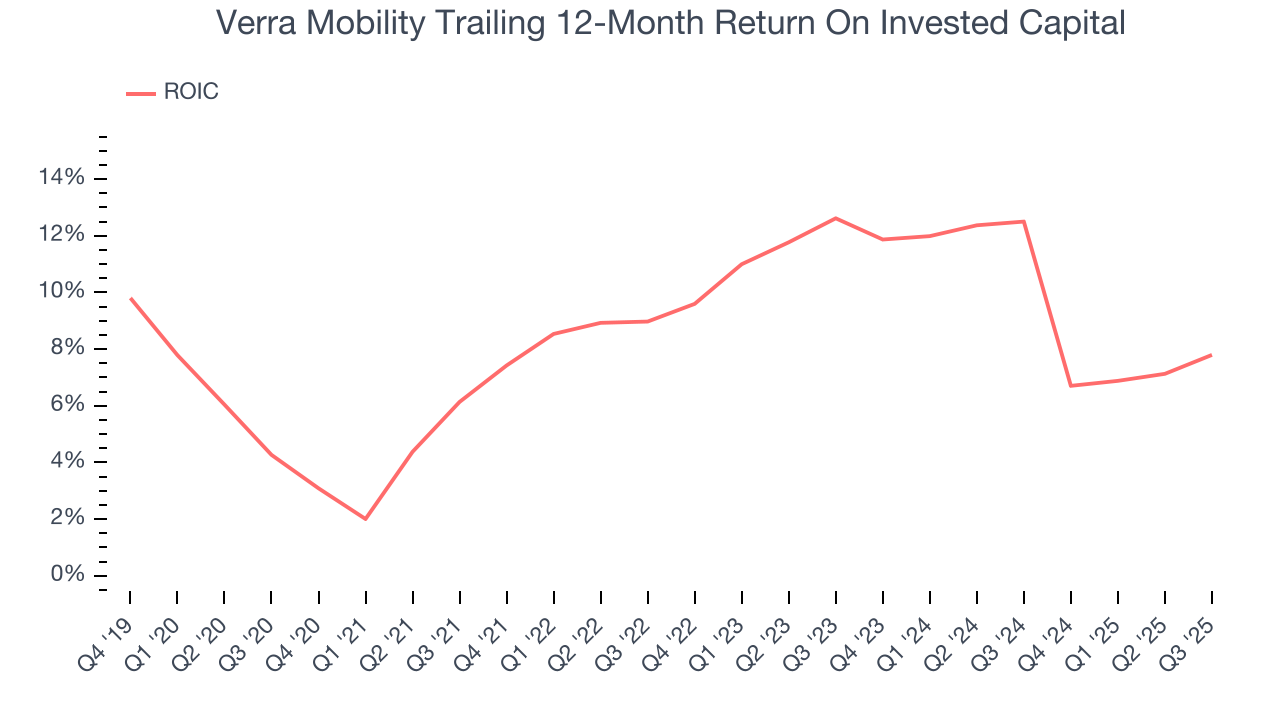
We like to invest in businesses with high returns, but the trend in a company’s ROIC is what often surprises the market and moves the stock price. Over the last few years, Verra Mobility’s ROIC averaged 2.6 percentage point increases each year. its rising ROIC is a good sign and could suggest its competitive advantage or profitable growth opportunities are expanding.
11. Balance Sheet Assessment
Verra Mobility reported $196.1 million of cash and $1.06 billion of debt on its balance sheet in the most recent quarter. As investors in high-quality companies, we primarily focus on two things: 1) that a company’s debt level isn’t too high and 2) that its interest payments are not excessively burdening the business.
With $416.1 million of EBITDA over the last 12 months, we view Verra Mobility’s 2.1× net-debt-to-EBITDA ratio as safe. We also see its $33.49 million of annual interest expenses as appropriate. The company’s profits give it plenty of breathing room, allowing it to continue investing in growth initiatives.
12. Key Takeaways from Verra Mobility’s Q3 Results
We were impressed by how significantly Verra Mobility blew past analysts’ revenue expectations this quarter. We were also glad its full-year revenue guidance trumped Wall Street’s estimates. Zooming out, we think this was a solid print. The stock traded up 5.3% to $25.05 immediately after reporting.
13. Is Now The Time To Buy Verra Mobility?
Updated: December 5, 2025 at 10:41 PM EST
Before deciding whether to buy Verra Mobility or pass, we urge investors to consider business quality, valuation, and the latest quarterly results.
There are things to like about Verra Mobility. To kick things off, its revenue growth was exceptional over the last five years. And while its projected EPS for the next year is lacking, its admirable gross margins indicate the mission-critical nature of its offerings. On top of that, its powerful free cash flow generation enables it to stay ahead of the competition through consistent reinvestment of profits.
Verra Mobility’s P/E ratio based on the next 12 months is 16.1x. When scanning the industrials space, Verra Mobility trades at a fair valuation. If you’re a fan of the business and management team, now is a good time to scoop up some shares.
Wall Street analysts have a consensus one-year price target of $29.33 on the company (compared to the current share price of $21.40), implying they see 37.1% upside in buying Verra Mobility in the short term.










